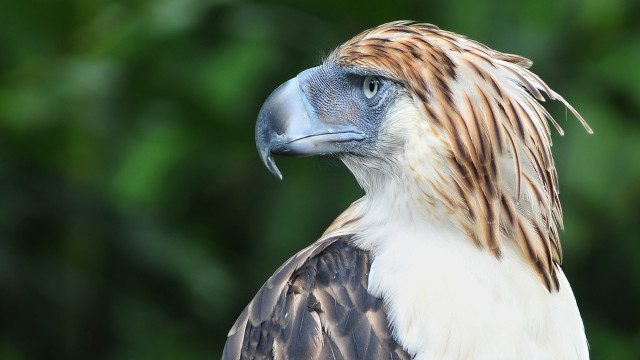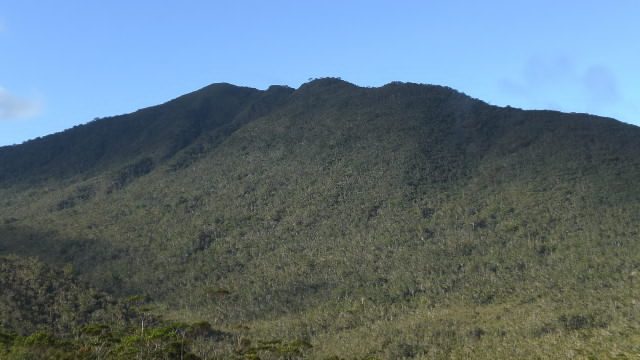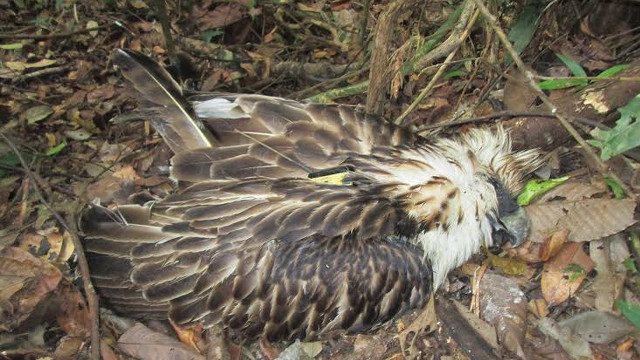SUMMARY
This is AI generated summarization, which may have errors. For context, always refer to the full article.

MANILA, Philippines – The recent death of Pamana, the Philippine eagle released in June in time for Independence Day, is shrouded in mystery.
The only facts are that she was killed by an airgun bullet and her body discovered on the fringes of a protected area – the UNESCO World Heritage Site Mount Hamiguitan Range.
She could have been shot on purpose, by a dedicated hunter. But her body, save for decomposition, was left intact. Could she have been shot by accident?
Whatever the circumstances, someone was able to get close enough to put a bullet through her chest.
Netizens exploded with anger and sadness over the killing. Some wanted the death penalty for the shooter. Others blamed the lack of awareness for the importance of the Philippine eagle, which is close to extinction.
Pamana’s death could be a symptom of a much larger disease – the alarming gaps in the way the Philippines manages its natural treasures.
Here are some telling facts:
1. Mount Hamiguitan Range already receives the highest government protection.
Pamana’s home is one of the few areas protected by a Republic Act (RA), the highest form of government protection.
This means it receives annual funds from the national government and has a dedicated Protected Area Management Board (PAMB) that should restrict access to critical portions of the mountain.

In a protected area, tourism activities are regulated. The local government and regional Department of Environment and Natural Resources (DENR) deploys forest guards to keep away poachers, miners, and loggers.
Last year, Mount Hamiguitan was named a UNESCO World Heritage Site, ranking it among the most important places in the globe.
The RA and the coveted accolade strengthened the government’s commitment – both at the national and provincial level – to safeguard Mount Hamiguitan. This active local support is why the Philippine Eagle Foundation chose the area to be Pamana’s new home.
So far, the national government has released P10 million for Mount Hamiguitan’s protection, says Environment Regional Director Marc Fragada. This is on top of funds to be allocated by the Davao Oriental provincial government.
There are 13 forest guards protecting Mount Hamiguitan’s 6,800 hectares, says Fragada, or one guard for every 525 hectares of the mountain range. This is much higher than the national average of one guard per 2,300 hectares.
And yet, despite everything, Pamana still met her death there. If such a tragedy can happen in Mount Hamiguitan, what’s to stop it from happening elsewhere, especially in the hundreds of critical habitats in the country that don’t receive the same amount of protection?
2. Pamana’s body was found in an area accessible to anyone.
She was not found in the heart of Mount Hamiguitan or what is called the “core protection zone” – a zone where only scientists or conservationists are allowed. Instead, her body lay in the “buffer zone,” an area open to anyone.
The truth is that despite the label “protected area,” not all parts of the area are restricted. In our laws, a protected area is divided into a core protection zone, special use zone, and buffer zone.
Only the core protection zone is off-limits. The special use zone can be accessed by tourists or locals who “sustainably” use the natural resources within the area. Locals include indigenous peoples who, for years, have depended on the area for food, shelter, and medicines.
In our law for protected areas, buffer zones are areas adjacent to protected areas which “need special development control in order to avoid or minimize harm to the protected area.”
Biodiversity Management Bureau (BMB) chief Theresa Mundita Lim says two things may have forced Pamana to go to the buffer zone: food scarcity within the mountain range or encroachment by humans inside the mountain range.
This poses many questions. Should buffer zones be protected too? Do we know enough about Philippine eagle habits to declare a wide enough area for their protection? Did humans enter core protection zones forcing Pamana out?
3. People live inside and around Mount Hamiguitan.
Conservationists themselves say you won’t find a protected area uninhabited by people.
There are around 40 households living inside Mount Hamiguitan, according to a DENR profile of the mountain. Villages adjacent to the protected area are often used as entry points. In fact, Pamana was found just one kilometer from one of them – Barangay La Union in San Isidro.
The close proximity of such communities means it’s likely locals are able to exit and enter the protected area even without the knowledge of forest guards.
It’s possible Pamana was killed by a local, whether on purpose or by accident.

Lim says the government has conducted intensive information campaigns to let villagers know the importance of their majestic winged neighbors. (READ: Apayao: Where ethnic tradition is saving the Philippine eagle)
But are these campaigns enough? Is it better to completely prohibit settlement inside the protected area?
4. Protected area management in the Philippines is the most underfunded in Southeast Asia.
The Philippine government spends only $0.93 or P43 to protect one hectare of an ecologically-important area, according to a recent study.
Compare this to Vietnam which shells out $13.44 or P623 per hectare. The same study found that the protected areas in the Philippines are underfunded by 324%, the biggest funding gap for conservation in Southeast Asia.
The lack of funds contributes to the lack of forest guards and conservationists.
It’s no wonder trespassing in even the most critical natural habitats is a walk in the park for those who know the area well enough.
But the government is trying to change things. In 2015, the BMB – the agency in charge of protected areas – received its highest budget of P1.2 billion. Three years ago, its budget was only P600 million.
But the BMB is a limited agency. It has no regional offices, depending on Protected Area Management Boards to enforce its policies. The PAMBs are composed of environment officials, mayors, governors, village leaders, the academe, and civil society groups – all of whom have other responsibilities aside from conservation.
5. Local communities are frontliners in conservation.
But no matter how much money the BMB allots for protected areas like Mount Hamiguitan, efforts will come to naught if the locals themselves don’t take ownership of conservation. (READ: 5 ways to improve how we protect our parks)
The dream formula for effective conservation is the involvement of as many stakeholders as possible, says Lory Tan, former chief executive officer of World Wide Fund for Nature (WWF) Philippines.
“The best managed protected areas in the country are Tubbataha Reef and the Puerto Princesa Underground River. Both share one management characteristic – they are under joint management. DENR shares [PAMB] co-chair status with the governor, or the mayor,” Tan says.
Provinces and towns with natural parks in their jurisdiction should be ready to fill in gaps left by the national government.
Additional layers of policy like provincial and municipal ordinances can help. Local government budgets can also be allocated to community education, organization, and enforcement.
Partnerships between the government and private sector might also work, Tan says.
Establishments that benefit from the conservation of an area might be convinced to contribute funds or manpower. For instance, water companies that depend on clean water from rivers or nearby hotels that cater to tourists attracted to a natural park in good condition.
The more people are involved in protecting animals like the Philippine eagle, the more eyes and ears will be alert for possible threats. This is the best protection against the eagle’s most effective killers: ignorance, apathy, and greed. – Rappler.com
Philippine eagle image via Shutterstock
Add a comment
How does this make you feel?
There are no comments yet. Add your comment to start the conversation.